Acanthodiscus is an extinct ammonoid cephalopod genus from the order Ammonitida and included in the persphinctacean family Berriasellidae. The type species, named by Bruguière, 1792, is Acanthodiscus radiatus.
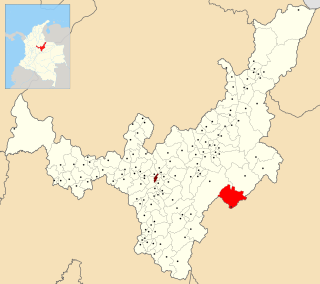
Pajarito is a town and municipality in the La Libertad Province, part of the Colombian department of Boyacá. The municipality, situated in the southeast of the department borders Labranzagrande and Aquitania of the department of Boyacá and Yopal, Recetor and Aguazul of the department of Casanare. The urban centre is located at a distance of 147 kilometres (91 mi) from the department capital Tunja at an altitude of 800 metres (2,600 ft) in a tight valley, not allowing much expansion of the urban area. The centre is experiencing periodic landslides.

Exogyra is an extinct genus of fossil marine oysters in the family Gryphaeidae, the foam oysters or honeycomb oysters. These bivalves were cemented by the more cupped left valve. The right valve is flatter, and the beak is curved to one side. Exogyra lived on solid substrates in warm seas during the Jurassic and Cretaceous periods.

The Paja Formation is an Early Cretaceous geologic formation of central Colombia. The formation extends across the northern part of the Altiplano Cundiboyacense, the Western Colombian emerald belt and surrounding areas of the Eastern Ranges of the Colombian Andes. In the subsurface, the formation is found in the Middle Magdalena Valley to the west. The Paja Formation stretches across four departments, from north to south the southernmost Bolívar Department, in Santander, Boyacá and the northern part of Cundinamarca. Well known fossiliferous outcrops of the formation occur near Villa de Leyva, also written as Villa de Leiva, and neighboring Sáchica.
Neoptychites is an extinct ammonoid cephalopod genus from the Turonian stage of the Upper Cretaceous, with a worldwide distribution.
Hoplitoides is an ammonite from the Upper Cretaceous, Turonian belonging to the Coilopoceratidae, a family in the Acanthoceratoidea. Hoplitoides have early whorls which are grooved, then flat, and finally narrowly rounded venters; early stages with umbilical tubercles and space ribs, later stages becoming smooth. The suture is similar to that of Coilopoceras but less extreme. Hoplitoides has an established distribution which is widespread, from western North America, northwestern Africa and northern South America.

Fagesia is a small, subglobular ammonite belonging to the vascoceratid family of the Acanthocerataceae that lived during the Turonian stage of the Late Cretaceous, 92–88 Ma ago.

Neocomites is a genus of ammonite from the Lower Cretaceous, Berriasian to Hauterivian, and type genus for the Neocomitidae.
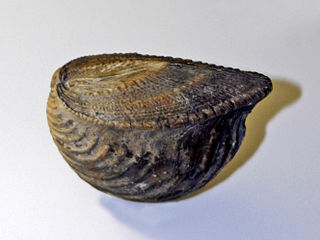
Trigonia is an extinct genus of saltwater clams, fossil marine bivalve mollusk in the family Trigoniidae. The fossil range of the genus spans the Paleozoic, Mesozoic and Paleocene of the Cenozoic, from 298 to 56 Ma.
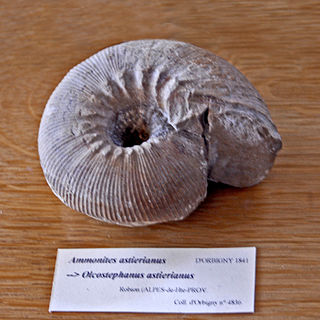
Olcostephanus is an extinct ammonoid cephalopod genus belonging to the family Olcostephanidae. These fast-moving nektonic carnivores lived during the Cretaceous, from the upper Valanginian to the lower Hauterivian age.
Codazziceras is an early Late Cretaceous ammonite from the Late Cretaceous of Colombia, distinguished from Lyelliceras (Lyelliceratidae) from which it is based and added to the Euomphaloceratinae (Acanthoceratidae). The type species is Codazziceras scheibei and another described species is C. ospinae. Fossils of Codazziceras have been found in the La Frontera Formation of Huila, Cundinamarca and Boyacá, and in the Loma Gorda Formation of Aipe, Huila.

The Guadalupe Group (Spanish: Grupo Guadalupe, K2G, Ksg) is a geological group of the Altiplano Cundiboyacense, Eastern Ranges of the Colombian Andes. The group, a sequence of shales and sandstones, is subdivided into three formations; Arenisca Dura, Plaeners and Arenisca Labor-Tierna, and dates to the Late Cretaceous period; Campanian-Maastrichtian epochs and at its type section has a thickness of 750 metres (2,460 ft).
The Murca Formation is a geological formation of the Altiplano Cundiboyacense, Eastern Ranges of the Colombian Andes. The predominantly subarkose sandstone with claystones and siltstones formation dates to the Early Cretaceous period; Valanginian epoch and has a maximum thickness of 924 metres (3,031 ft).
María Euridice Páramo Fonseca is a Colombian paleontologist and geologist. She has contributed to paleontology in Colombia in the fields of describing various Cretaceous reptiles, most notably the mosasaurs Eonatator and Yaguarasaurus, the ichthyosaur Kyhytysuka, and the plesiosaurs Leivanectes and Stenorhynchosaurus.
Fernando Etayo Serna is a Colombian paleontologist and geologist. His contributions on the paleontology in Colombia has been mainly on the descriptions of ammonites and Etayo has helped describing many fossiliferous geologic formations of Colombia. Etayo obtained his MSc. degree in geology and geophysics from the Universidad Nacional de Colombia in 1963, and his PhD in paleontology from the University of California, Berkeley in 1975.
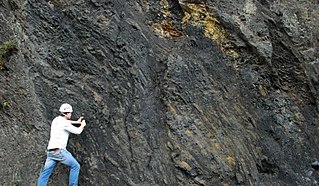
The Macanal Formation or Macanal Shale is a fossiliferous geological formation of the Altiplano Cundiboyacense and Tenza Valley in the Eastern Ranges of the Colombian Andes. The predominantly organic shale formation dates to the Early Cretaceous period; Berriasian to Valanginian epochs and has a maximum thickness of 2,935 metres (9,629 ft). The Macanal Formation contains numerous levels of fossiliferous abundances. Bivalves, ammonites and fossil flora have been found in the formation.
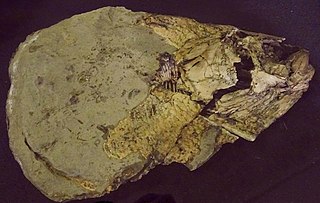
Bachea is an extinct genus of ray-finned fish that lived during the Late Cretaceous in what is now central Colombia, South America. The type species is Bachea huilensis, described in 1997 by María Páramo from the Turonian of Huila, Colombia.

The Chibcha Terrane, named after Chibcha, is the largest of the geological provinces (terranes) of Colombia. The terrane, the oldest explored domains of which date to the Meso- to Neoproterozoic, is situated on the North Andes Plate. The megaregional Romeral Fault System forms the contact of the terrane with the Tahamí Terrane. The contact with the Caribbean and La Guajira Terranes is formed by the regional Bucaramanga-Santa Marta Fault. The northeastern boundary is formed by the regional Oca Fault, bounding the La Guajira Terrane. The terrane is emplaced over the Río Negro-Juruena Province of the Amazonian Craton along the megaregional Eastern Frontal Fault System.










